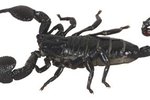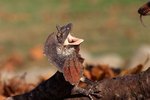Armadillo lizards (Cordylus cataphractus) -- sometimes also known as armadillo girdled lizards -- are found along South Africa's west coast from Orange River to the Piketberg Mountains. Their body usually measures between 2 and 4 inches long, with a tail of roughly the same length again. These creatures have developed several useful adaptations to help them survive.
Like An Armadillo
This species is called the armadillo lizard for good reason -- when threatened, they curl themselves into a tight ball. Much like an armadillo, they roll themselves up, gripping their tail in their jaws, and form an armoured sphere. This position protects their soft undersides. Because its body is covered in tough spines, most predators who try to eat one when in this defensive position will end up with a spiky mouthful. Unfortunately for these lizards, it doesn't prove too effective against birds of prey.
Losing Tail
Armadillo lizards have another trick up their sleeves when it comes to avoiding predation -- they're able to detach their tails from their bodies at will. Since their tails play an important role when they curl up in their defensive position, they'll only detach them when under extreme duress. After all, losing a tail is better than becoming someone else's dinner. They can grow new tails for themselves, but it takes a long time and they're more vulnerable in the interim.
Powerful Jaws
Although they'd rather hide from predators than fight them, armadillo lizards have adapted extremely powerful jaws that they use to attack any creatures who threaten them. They've been known to sever the toes, or even small limbs, of their opponents in a fight. Members of this species can also be very territorial, so they use these strong jaws in fights to defend their home turf, as well.
Feeding and Metabolizing
Since armadillo lizards live in areas that don't have abundant food all year long, they've developed adaptations to help them survive times of scarce nutrition. When the wet season comes and food is abundant, they're extremely active and gain weight quickly. During this time, they primarily feed on southern harvester termites. However, when the dry season arrives and food is scarce, they're able to slow their metabolisms down to survive this period of poor sustenance.




